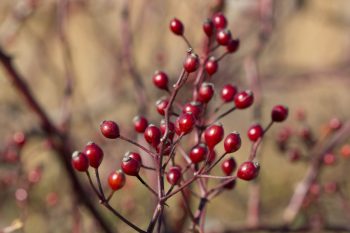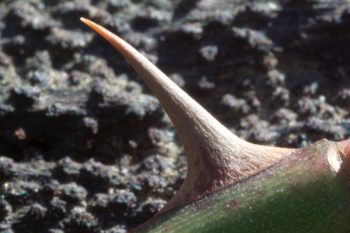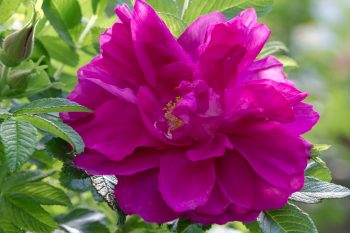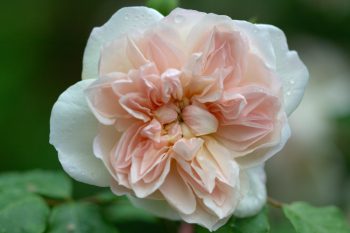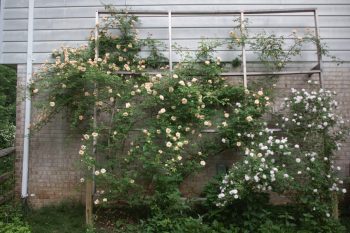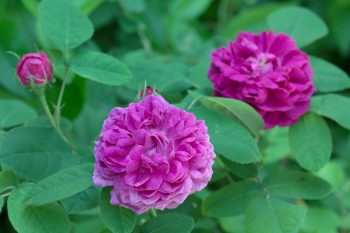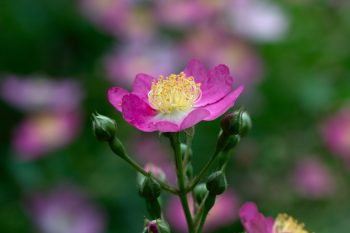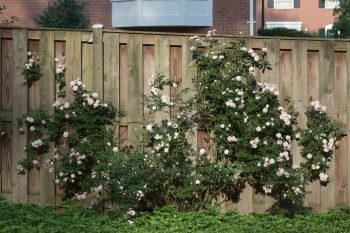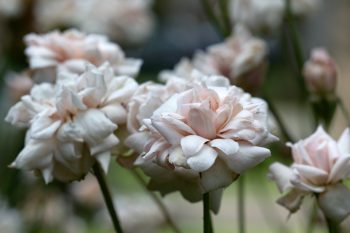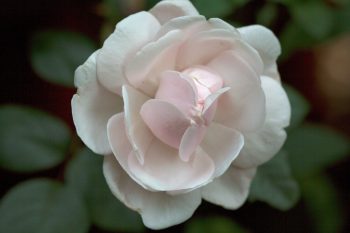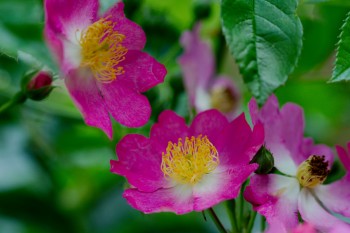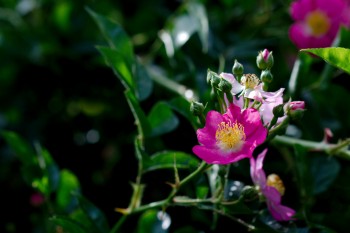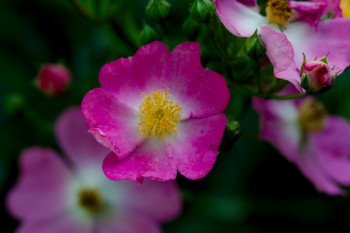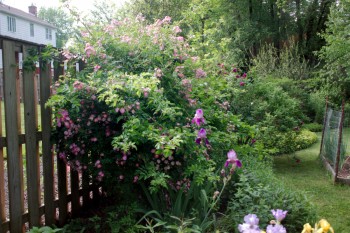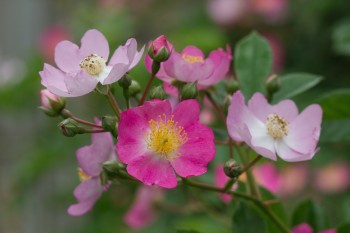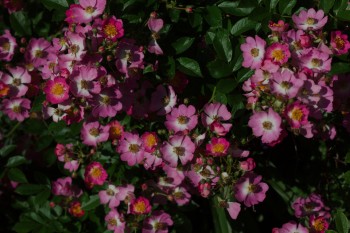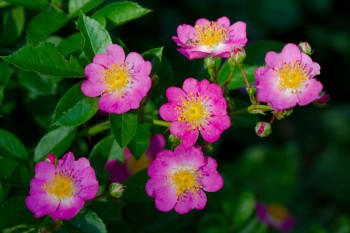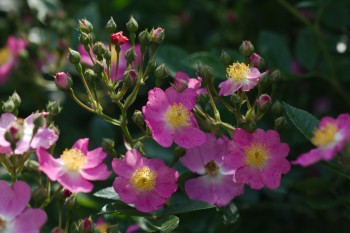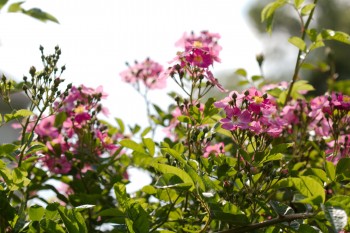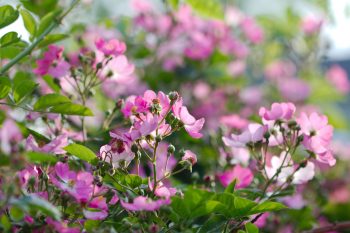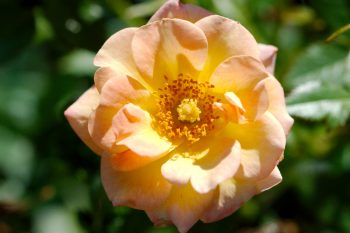As I was taking this picture, I startled (and was in turn startled by) a rabbit who took off into the grass. I was able to track him in the snow but each time I got close, he saw me before I saw him and he darted away. Anyway, I’m a sucker for any sort of berry, particularly red berries. And yes, I know rose hips aren’t berries. Strawberries and raspberries aren’t berries, either. So there.
Tagged With: Rose
Rose Thorn
I didn’t find much to photograph today and wasn’t out very long. I did take a few pictures of this rose thorn with my micro set-up. It is about 3/8 of an inch long.
Rose ‘Roseraie De l’Hay’
This is a nice rugosa hybrid that booms all summer long. The flowers have an intense clove scent that I really love. The only downside is that the shrub is so tall and most of the roses are on the top so you usually see them from below. Still, it will have a lot of blooms shortly and will be something to see.
‘Jaune Desprez’
I wish you could smell this rose. This is a Noisette rose called ‘Jaune Desprez’ (Desprez, France, 1835). The individual blooms are not the most beautifully shaped in all creation but it blooms reliably and grows pretty vigorously.
Rose Trellis
Last summer Kevin helped me build this rose trellis. The roses haven’t had a chance to fill in completely but it’s starting to look pretty good.
On the right is ‘Champneys’ Pink Cluster’ (Champneys, U.S., 1811). Although it isn’t really a climbing rose the support is helpful, anyway. On the left is ‘Crépuscule’ (Francis Dubreuil, France, 1904). Both of them are Noisette roses and bloom pretty well off and on all summer. ‘Crépuscule’ has the stronger scent but both are nice in that regard.
‘Rose de Rescht’
This is the rose that I was taking pictures of when I found the little frog Thursday evening. There are more flowers open now so it’s a better picture today than it was then, anyway. This is a little Portland rose called ‘Rose de Rescht’ which was brought to England by Miss Nancy Lindsay from Iran or France (it’s so easy to get those confused), before 1900. It’s a small shrub (two to three feet at most). I’ve been growing it in a large pot but I really should find a permanent place for it in the ground.
A Pink Multiflora Rose
Normally I’d be the last person to suggest that anyone grow a multiflora rose. About them the great plantsman Michael Dirr says, “use this species with the knowledge that none of your gardening friends in the immediate vicinity will ever speak to you again.”
Still, when I came across a bright pink multiflora — it is almost certainly a natural hybrid but it is a multiflora in every way except petal color — I decided I had to have it. I dug up a small piece and it’s thriving on my back fence. The parent plant was destroyed, so I got it just in time.
It’s really a lovely shrub and it is absolutely covered with hundreds of flowers and thousands of buds. Just don’t tell Spencer.
‘Blush Noisette’
This rose has taken a bit longer to get established than the others but it’s starting to look pretty good. ‘Blush Noisette’ (Noisette, France, before 1817) is a pretty little rose with a terrific fragrance. If you’re counting, this is the fourth and final Noisette rose in my garden. It’s not actually in full bloom yet, having a half dozen buds for every open flower.
Nick Weber’s Heritage Rosarium
I spent the better part of the day at Nick Weber’s Heritage Rosarium today, taking over 350 photographs of roses. What a wonderful place to be. Just before 1:00 PM a very heavy rain shower came through and we all watched it from the shelter of the gazebo.
I decided to take a panorama of the garden in the rain, and took nine shots that have been stitched together to form this image. As you can see, the tripod head wasn’t completely level so the image slopes a bit but this gives you a bit of an idea what Nick’s main garden looks like.
Thank you Nick and Rosanne.
‘Perle d’Or’
Next to our front door is this sweet little China rose, ‘Perle d’Or’ (Joseph Rambaux/Rambaud, France, 1884). It’s just about through with it’s first main flush but it will have at least a few flowers on it from now until the first frost. A wonderful scent, as well.
‘New Dawn’
On August 31, 1931, the U. S. Patent Office granted plant patent number 1 to Henry Bosenberg for the rose ‘New Dawn’. There’s a lot to like about this rose but not least is that it so reliably reblooms and it has such beautiful, shiny green foliage that doesn’t have problems with black spot, even here in Maryland. I got my plant from my coworker, Kamala and it’s growing up and over the back fence. This brings “rose week” to a close as this is the last of the nine roses in our garden.
Multiflora Rose
Last year in my Project 365 I posted a picture of this rose on Day 142, May 22, 2011. I know that you have to be a bit daft to actually plant a multiflora rose, particularly in a small garden. The great English rosarian, Graham Stuart Thomas, says in The Graham Stuart Thomas Rose Book (Sagapress, 1994):
It can best be described as an arching shrub, although its shoots will ramble into trees as high as 20 feet. Normally it makes a dense thicket of interlacing lax shoots, much like a blackberry. So dense is it, indeed, that when planted closely as a hedge it is rabbit-proof, and so thickly do its stems grow that it is becoming increasingly popular in the United States and also in Britain as a roadside plant, for its resilient thicket can hold a car which runs off the road. What a use for a rose! On the other hand, how lucky we are to be able to provide so pretty and sweet a shrub for such a use. It is claimed in America that it is “horse high, bull strong and goat tight.
Thomas, of course, was a rose person. How bad can any rose be? On the other hand, Michael A. Dirr is a more general horticulturalist. He has a little different opinion of R. multiflora in his well respected, 1,187 page Manual of Woody Landscape Plants (Fifth Edition, Stipes Publishing, 1998).
Under the heading “Habit” he says, “A fountain with long, slender, recurving branches; eventually forming an impenetrable tangle of brush suitable only for burning.” About its growth rate he says, “fast; too fast for most farmers who have this species in their fields.” His description for “Culture” is, “Same as described under R. rugosa although this species is more invasive; tolerates dry heavy soils very well.”
He goes on with an entry for “Landscape Value” of “None in the residential landscape; has received a lot of attention for conservation purposes; makes a good place for all the ‘critters’ to hide, yet can be a real nuisance for the birds deposit the seeds in fence rows and open areas, and soon one has a jungle; use this species with the knowledge that none of your gardening friends in the immediate vicinity will ever speak to you again.” Finally, he gives the following “Additional Notes.” “Utilized as an understock for budding the highly domesticated selections. Another species that appears resistant to black-spot and the typical rose diseases. I cannot overemphasize the invasive and greedy nature of this species. Have observed entire pastures/fields invaded and captured by the plant.”
Having said all that, I’m a fan of places for all the critters to hide. Also, this pink sport or more likely a natural hybrid, was growing at the edge of the woods near my office. I dug up a small piece and within a month all that was growing there had been sprayed and killed. Some would argue that I should have let it all be killed but this pink version, which is very similar in almost every way to the species, seemed worth keeping. The difference it in the flowers — they are larger than the species, as well as being a beautiful, dainty pink. There are somewhat fewer of them, but still enough. The leaves seem entirely free of rust, mildew, and black-spot.
Actually, my ultimate goal is to try to produce a tetraploid version of this diploid rose. That would be valuable for hybridizing, because some many important roses are tetraploid. Whether I can actually do that remains to be seen. In the meantime, I’ll continue to prune this hard, trying to keep it contained, and I’ll do it with the knowledge that none of my gardening friends in the immediate vicinity will ever speak to me again.
Pink Rosa multiflora
Another rose photo taken on Monday. Don’t worry, I’m almost out of roses. I posted a few pictures of this rose on May 12 last year along with a fairly lengthy description of R. multiflora. That should be enough of a description to keep anyone from planting this in their garden, but then, this pink version is a little special. Wouldn’t it be nice to get this pink color, along with the well known multiflora resistance to blackspot and incredible vigor, into a repeat flowering rose? That’s my ultimate goal. Not sure what to cross it with, at this point, but I’m thinking. I’d also like to try my hand at creating a tetraploid version of this rose and see what that looks like. Of course, I’ve been meaning to work on that for quite a few years. Some day…
Pink Multiflora Hybrid
The roses are really starting to bloom, finally. This is one that only blooms once during the year but it’s beautiful when it does. It also have very healthy, disease resistant foliage, so it looks pretty good the rest of the year, although it’s just green, of course. This is a found rose and seems to me to be mostly R. multiflora. The wonderful pink flowers, however, speak of some other genes in the mix. I think this rose might contribute to some interesting breeding work and for years I’ve considered it, but so far, haven’t actually done anything.
Rosa multiflora
It’s time for my annual photo of the Rosa multiflora hybrid I have in our back garden. This is a natural hybrid, found growing in the woods near my office. The parent plant is no longer there, because about a month after I dug up a piece it was sprayed and killed. Normally that’s the right thing to do with R. multiflora but this one is special to me, because of the pink blooms that cover the plant this time of year for about a week. It’s quite lovely. It would be even better, of course, if it repeated but one cannot have everything. It’s a vigorous plant, as one would expect with a multiflora hybrid, and handsome as a large patch of green on the back fence, even when not in bloom. It takes a bit of extra care, pruning and cutting out dead wood every couple years, but it’s well worth the effort. That effort is made more difficult by the quantity (large) and quality (also large and very sharp) thorns that absolutely cover the canes. Still, worth it.
Multiflora Buds In The Rain
The rain continued today but I went out briefly to take a few pictures. The large, pink Rosa multiflora (or mostly multiflora, anyway) shrub against our back fence is covered with buds and is just starting to come into bloom. In a few days, and certainly in less than a week, it will be covered with pink flowers. At this point there are only occasional flowers and lots and lots of buds. But in the rain, even that can be pretty, I think. It builds anticipation, if nothing else.
Rosa Multiflora
A few days ago this plant was a mass of buds in the rain. Now the rain has stopped and the buds are opening. Individually the flowers are not really all that amazing, five small, simple, pink petals around a bunch of yellow stamens. In mass they are quite impressive. The entire plant is turning from green to pink and will get pinker before it is done. I picked out one picture to post here and then second guessed myself. I found that I couldn’t decide which one I liked better so I’m posting them both.
Of course, like most rose species, this one only blooms once and then it’s done for the year. It also has very little fragrance. My dream is to cross this with roses that repeat and which have fragrance to get some of the multiflora vigor and disease resistance into a new group of hybrids. Whether that’s ever going to happen is anyone’s guess. Another project, even before crossing it with anything else, is an attempt to double the chromosomes. R. multiflora is, like many rose species, diploid (it has 14 chromosomes). Many hybrid garden roses, including most hybrid teas and floribundas and a lot of the roses I’d cross like to make crosses with, are tetraploid (28 chromosomes). For breeding purposes, a cross between a diploid and a tetraploid is problematic because it produces triploid offspring, which are, with notable exceptions, sterile.
Rosa multiflora
My pink multiflora rose is in full bloom. I suspect it isn’t 100% R. multiflora, because those have white flowers and this is clearly not white. What the rest of its genetic makeup is, I really couldn’t say. R. virginiana would be a reasonable guess. The color is right. The leaves are definitely R. multiflora and it’s got the requisite resistance to black spot. It’s possibly a bit less vigorous, but that’s probably something in its favor. R. multiflora will generally take over and this is large, but fairly well behaved. Pity it only blooms once, but then, the same can be said for the azaleas.
Rose ‘Cutie Pie’
I’ve mentioned this rose a couple times so I decided that I’d finally get around to posting a picture. This is a miniature rose called ‘Cutie Pie’ and it is, really. I’ve found two roses named ‘Cutie Pie’ listed in commerce. This is WEKruruwel, Bred by Tom Carruth and introduced by Weeks in 2016. So, it’s a new rose. I’ve planted it in the large bed in the middle of our back yard where there used to be two trees. That bed needs a bit more variety and this was my start at that. I plan to add a few more roses, two at least and maybe as many as four. I’m looking at a few of David Austin’s English roses. We’ll see.
Rosa rugosa ‘Roseraie De l’Hay’
I’m not sure what happened last year but for some reason, most of my roses died. One of them, a pink flowered R. multiflora hybrid, isn’t quite gone, with one branch left. This R. rugosa named ‘Roseraie De l’Hay’ also has some life left in it. Nevertheless, there’s a fair amount of dead wood to prune out. ‘Blush Noisette’ appears to be completely dead. It was never a very vigorous shrub but for it to simply die completely was unexpected. I lost my ‘New Dawn’ last year, but that I had to dig up because of rose rosette disease, is caused by Emaravirus species of virus.

